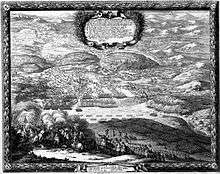Battle of Wojnicz
| ||||||||||||||||||||||||||
The Battle of Wojnicz was fought on October 3, 1655 between forces of the Polish-Lithuanian Commonwealth commanded by Field Crown Hetman Stanisław Lanckoroński and Great Crown Hetman Stanisław Rewera Potocki on one side, and on the other Swedish forces commanded by Charles X Gustav. The battle ended in Swedish victory.
In the early stages of the Siege of Krakow, Polish royal units of Hetman Lanckoronski decided to abandon the city, as the situation of the defenders was hopeless. Together with king Jan Kazimierz, the Poles headed eastwards, to Tarnów. At some point, the king with the royal court turned southwards, to Nowy Wisnicz and Nowy Sacz, while the army of Lanckoronski joined units under Hetman Potocki.
Swedish king Charles Gustav, who commanded the siege of Krakow, decided to chase the Poles, leaving Arvid Wittenberg with 8,000 soldiers in Krakow. Charles Gustav had app. 5,000 soldiers, mostly infantry, while Polish units were more numerous, including the hussars under Stanislaw Koniecpolski. The Poles camped among the hills in the vicinity of the town of Wojnicz, near the Dunajec river.
Due to poor visibility, the Swedes sent two cavalry regiments for reconnaissance purposes. The regiments clashed with Polish cavalry, which was sent for the same purpose. The skirmish turned into a full-scale battle, which took place in the Polish camp, among tents. Charles Gustav quickly sent reinforcements, attacking wings of the Polish cavalry. Under pressure of disciplined Swedish musketeers and their firepower, the hussars, who were elite force of the Polish army, had to retreat behind the Dunajec. Stanislaw Lanckoronski narrowly escaped death.
The battle, yet another Polish failure resonated profoundly across the Commonwealth. In nearby Tarnow, where the Poles fled, thousands of soldiers switched sides and joined Charles Gustav. Among them were Dymitr Wisniowiecki, Aleksander Koniecpolski and Jan Sobieski, the future king, who hoped that the Swedes would help Poland in the never-ending wars in the east.
Swedish units
- 1. Kungliga hästgardet (400) or Müllers Reiter
- 2. Smålands Reiter (800)
- 3. Wittenbergs Reiter (600)
- 4. Dismounted Dragoon (Berndes Dragoon) and Commanded Musketeers (?) (700)
- 5. Yxkulls Reiter (550)
- 6. Sulzbachs Reiter (650)
- 7. Böddekers Reiter (550)
- 8. Pretlachs Reiter (850)
- 9. Ridderhielms Reiter (600)
Polish units
A. Lanckoronski - 2,600 kosack (pancerni) cavalry B. Wisniowiecki - 400 hussars and C. Koniecpolski - 2,600 kosack cavalry D. Denhoff - 460 dismounted dragoon in a fortified camp
- Hetman St.Lanckoronskis Banner
- Wlad. Myszkowskis Banner
- Adam Dzialynskis Banner
Kosack Cavalry -
- Approximately 70 banners
Dragoon -
- Col. Henr. Denhoffs Regiment
- Hetman Lanckoronskis Banner
- Alexander Koniecpolskis Banner
References
External links
Coordinates: 49°58′00″N 20°50′00″E / 49.966667°N 20.833333°E
